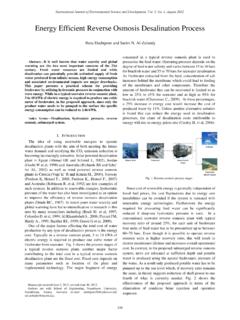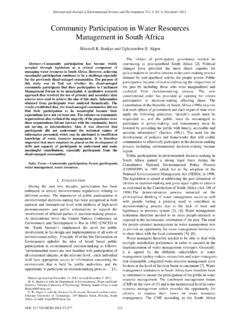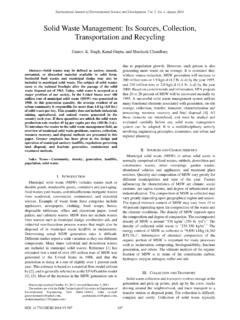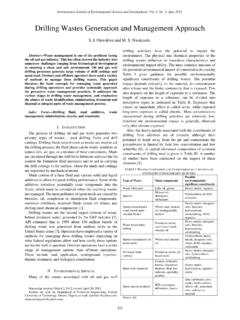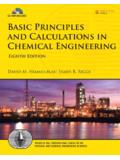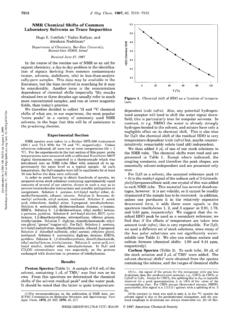Transcription of An Agricultural Pollutant: Chemical Fertilizer - IJESD
1 Abstract Consumer society, in order to meet the growing need for food, Agricultural land per unit area required to achieve maximum efficiency and highest quality product. It is known that the nutrition of the plant is the one of the most important factors to control Agricultural productivity and quality. Rates of nutrients in the soil affects the quality of yield. In the permanent Agricultural land, the soil will be very poor in nutrients, as a result, inefficient. Therefore, producers, fertilize the soil, combat pests, irrigation and process of Agricultural activities to make more efficient to soil.
2 Fertilization among these activities remains a priority at all times. Recent studies, however, excessive use of fertilizers is the need for additional land outside the public and environmental health of the reported adverse affects. Excessive fertilization and mindless, but there were soil salinity, heavy metal accumulation, water eutrophication and accumulation of nitrate, to consider in terms of air pollution in the air of gases containing nitrogen and sulfur, giving and can lead to problems such as the greenhouse effect.
3 In this review, aims to reveal environmental and health problems caused by improper fertilization provides recommendation toward solving these problems. Index Terms Agricultural pollution, environment, fertilization I. INTRODUCTION Fertilization increases efficiency and obtains better quality of product recovery in Agricultural activities. It is one of the most important ways. Non-organic fertilizers mainly contain phosphate, nitrate, ammonium and potassium salts. Fertilizer industry is considered to be source of natural radionuclides and heavy metals as a potential source.
4 It contains a large majority of the heavy metals like Hg, Cd, As, Pb, Cu, Ni, and Cu; natural radionuclide like 238U, 232Th, and 210Po [1-2] . However, in recent years, Fertilizer consumption increased exponentially throughout the world, causes serious environmental problems. Fertilization may affect the accumulation of heavy metals in soil and plant system. Plants absorb the fertilizers through the soil, they can enter the food chain. Thus, fertilization leads to water, soil and air pollution. The use of Chemical fertilizers in Turkey is lower than developed and many developing countries.
5 Chemical Fertilizer used per hectare in Turkey (N+P+K) are determined as These values are in the Netherlands; in Egypt; in Japan; in China; in Britain; in Germany; in France; in the USA; in Italy; in India; in Greece and in Indonesia kg/ha respectively [1]. Manuscript receive January 15, 2012, revised Februaruy 1, 2012. Serpil Savci is with the Biosystems Engineering Department in Bozok University, Turkey For the next 30 years, more Fertilizer will be used to obtain more products. Excessive use of Chemical fertilizers in agriculture, resulting in a large number of environmental problems because some fertilizers contain heavy metals (eg.)
6 Cadmium and chromium) and high concentrations of radionuclides. Later these fertilizers agro-ecosystem constitutes the main source of heavy metals and radionuclides in plants and some results in the accumulation of inorganic pollutants [3]. Greenhouses, aquaculture especially large amounts of Chemical fertilizers used during the peak season, so dangerously polluted well water, especially water resources, crop production quantity and quality of product deteriorates. Problems caused by too much Fertilizer : The amount of nitrate may increase in drinking water and rivers as a result of high levels of nitrogen Fertilizer use.
7 The amount of phosphate may increase in drinking water and rivers as a result of the transport of phosphorous Fertilizer with the flow of surface. High level of Nitrogen Fertilizer used plants grown in soils. It consists of carcinogenic substances such as nitrosamines, especially plants such as lettuce and spinach leaves are eaten. There are harmful accumulation of NO3 and NO2 [2-3] . II. EFFECTS OF Chemical fertilizers ON WATER POLLUTION Nowadays, human beings aware of harmful effects on the environment of the use of nitrogenous fertilizers .
8 Nitrogen in Agricultural areas reach the water environment by three ways: Drainage, leaching and flow. Nitrate leaching particularly linked to Agricultural practices such as fertilizing and cultivation. Irrigated Agricultural land in some of the arid and semiarid regions, increased amounts of nitrate accumulation in the soil used and along with the evaporation of water. According to the conditions, nitrate accumulated leached in varying amounts. It reaches the depth of soil. In the soil, fertilizers converted to nitrate through nitrification by microorganisms.
9 Due to negatively charged of nitrate can reach ground water. Even in ideal conditions, Plants use 50% of nitrogenous fertilizers applied to soil, 2-20% lost evaporation, 15-25% react organic compounds in the clay soil and the remaining 2-10% interfere surface and ground water [4-5]. The majority of nitrogenous fertilizers aren't absorbed products and they interfere with both underground and surface water. Groundwater nitrate problem should be considered in a global context. 22% of cultivated areas in Europe for the international recommended dirinking water nitrate concentration in graundwater concentration ( mg/L) above.
10 In European Countries, NO3-N concentration value is 23 mg/L and in the USA it is 45 mg/L. NO3 and NH4+ An Agricultural pollutant : Chemical Fertilizer Serpil SavciInternational Journal of Environmental Science and Development, Vol. 3, No. 1, February 201277concentration, Nottingham, United Kingdom exceeds the stated limits. The city of Nottingham is underlain by the unconfined Sherwood aquifer, which is vulnerable to contamination from various sources arising from urban and industrial activities of the region. According to that study, samples of aquifer recharge, both artifical and natural, and of shallow and deep groundwater were collected to determine the sources and level of contamination from nitrogen species.


